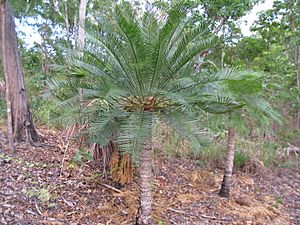Cycas armstrongii facts for kids
Quick facts for kids Cycas armstrongii |
|
|---|---|
 |
|
| Conservation status | |
| Scientific classification | |
| Genus: |
Cycas
|
| Species: |
armstrongii
|
Cycas armstrongii is a special type of plant called a cycad. Cycads are ancient plants that look a bit like palms or ferns. This particular cycad is found only in the Northern Territory of Australia.
You can find Cycas armstrongii growing from the Finniss River in the west to the Arnhem Highway in the east. It lives north of a town called Pine Creek. It also grows on the Tiwi Islands and the Cobourg Peninsula.
Contents
What Does Cycas armstrongii Look Like?
This cycad usually grows to about 3 meters (10 feet) tall. Sometimes, it can even reach 6 meters (20 feet)! Its trunk is about 5 to 11 centimeters (2 to 4 inches) wide.
Its Unique Leaves
One cool thing about Cycas armstrongii is its leaves. Unlike most cycads, its leaves fall off during the dry season. This is called being deciduous, just like some trees lose their leaves in autumn. However, if the plant gets enough water, its leaves might stay on.
The leaves are long, about 55 to 90 centimeters (22 to 35 inches). Each leaf has many smaller parts called leaflets, usually between 100 and 220 of them. When they first grow, these leaflets are a bit orange and fuzzy. Later, they turn shiny bright green on top and lighter green underneath. Each leaflet is about 5.5 to 14 centimeters (2 to 5.5 inches) long. A grown plant can have around 50 leaves at its top.
Cones and Seeds
Like other cycads, Cycas armstrongii produces cones, not flowers. These cones hold the plant's seeds or pollen.
- Female cones: These cones open up and have special parts called sporophylls. Each sporophyll is about 13 to 22 centimeters (5 to 9 inches) long. They can hold 2 to 4 seeds. When the seeds are ready, they have a yellow outer coating.
- Male cones: These cones are oval-shaped and orange. They are about 11 to 20 centimeters (4 to 8 inches) long and 7.5 to 10 centimeters (3 to 4 inches) wide. The top part of the male cone comes to a point.
This plant usually produces its fruits and seeds from March to September.
Where Does Cycas armstrongii Live?
This cycad is very common in the open forests and woodlands around the Darwin area. It grows north of Pine Creek. It prefers to grow in sandy soils that drain water well, or in soils rich in iron, called lateritic soils.
Sometimes, people might confuse Cycas armstrongii with another cycad called Cycas maconochiei.
How Does Cycas armstrongii Survive?
The areas where this cycad lives often have grass fires every year. But Cycas armstrongii is very good at handling fire. It is known as "fire fern" because these early spring fires actually help it! After a fire, the plants often grow lots of new leaves.
This cycad is one of the most common cycads in the world. Experts believe there are over ten million of these plants. This means its conservation status is "secure," so it is not currently in danger.
Why is it Called Cycas armstrongii?
The plant is named after a person called John Francis Armstrong. He was a plant collector from Kew Gardens in England. He worked in Port Essington, which is on the Cobourg Peninsula, and sadly passed away in 1847.
See also
 In Spanish: Cycas armstrongii para niños
In Spanish: Cycas armstrongii para niños


